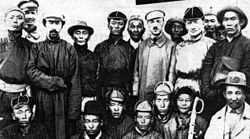Dogsomyn Bodoo
| Dogsomyn Bodoo Догсомын Бодоо | |
|---|---|
 | |
| Prime Minister of Mongolia | |
| In office April 16, 1921 – January 7, 1922 | |
| Preceded by | Dambyn Chagdarjav |
| Succeeded by | Jalkhanz Khutagt Sodnomyn Damdinbazar |
| Personal details | |
| Born | 1 July 1895 Mandshir Hutagt, Töv Province, Mongolia |
| Died | 31 August 1922 (aged 27) Khüree |
Dogsomyn Bodoo (Mongolian: Догсомын Бодоо; July 1, 1895 – August 31, 1922[1]) was a prominent early 20th century Mongolian politician who was one of the founding members of the Mongolian People's Revolutionary Party. He was elected leader of the provisional revolutionary government and following the Outer Mongolian Revolution of 1921 became the country's first Prime Minister from July 1921 to January 1922. A power struggle led to his resignation on January 7, 1922. He was subsequently charged with treason for conspiring to overthrow the government, and was executed on August 31, 1922.[2][3]
Early life

Bodoo was born in 1895 in Mandshir Hutagt in present-day Töv Province. He obtained his elementary education at the Manjusri Monastery and then studied at the Mongolian Language and Literature School in Khüree (present-day Ulan Bator). He later became a scribe at the Shaviyn Yaam (religious affairs office) and then a Mongolian Language teacher at the Russian-Mongolian School for Translators.[4] He was literate in Mongolian, Tibetan, Manchu and Chinese.[5] He became the Khüree representative of the Harbin newspaper Mongolyn Sonin Bichig and, under the pseudonym Bold or Bo, correspondent and editor of Shine Tol' and Niislel Hüreeniy Sonin Bichig newspapers.[6]
Founding of the Mongolian People's Party
Exposed to Russian Bolshevism through his contacts and acquaintances at the Russian consulate, Bodoo founded the secret anti-Chinese resistance and revolutionary organization Konsulyn Denj (Консулын дэнж or Consular Hill group) after the occupation of Khüree by the Chinese general Xu Shuzheng in late 1919. Other members of the group included Dambyn Chagdarjav, Darizavyn Losol, and Khorloogiin Choibalsan, who acted as Bodoo's Russian interpreter.[7] Encouraged by contacts at the Russian consulate, Bodoo's group eventually merged with another resistance group Züün Hüree whose membership included Soliin Danzan, Dansrabilegiin Dogsom, and Damdin Sükhbaatar. On June 25, 1920,[8] the new organization renamed itself the Mongolian People’s Party (MPP).[9]
Bodoo was a member of the first MPP delegation that included Choibalsan, Danzan, Losol, Chagdarjav, Dogsom, and Sükhbaatar (the famous "First Seven") that journeyed to Russia to establish contact with the Soviets in 1920.[10] He was named Minister of External Affairs in the provisional government at the MPP conference (subsequently regarded as the first congress of the Mongolian People's Revolutionary Party) held secretly in Troitskosavsk, Russia from March 1 to 3, 1921. A month later he was also named Prime Minister after Chagdarjav was relieved of the position.[11]
Prime minister
Bodoo became the Prime Minister and Foreign Minister of the revolutionary government following the "liberation" of Khüree from forces loyal to Roman von Ungern-Sternberg by joint Mongol and Red Army forces on July 6, 1921. He signed and issued Mongolia's Declaration of Independence on September 14, 1921.[12]

Soon thereafter, however, the political rivalry between Bodoo and Soliin Danzan intensified when Danzan lost his seat as party leader to a relative of Bodoo's. Danzan, who was Minister of Finance, engineered various plots to oust the Prime Minister from office by persuading influential figures that Bodoo was "short-tempered, short-sighted" and not a serious person.[13]
Downfall
Danzan's accusations gained traction in late 1921 after Bodoo's campaign (initially instigated by the Soviets) to "modernize" the people by forcibly cutting off “feudal” ornaments from Mongolian deels such as large cuffs, women’s jewelry, and even long hair resulted in an angry public backlash.[14] Sensing Bodoo's weak political position, Danzan accused him of plotting with the charismatic independence leader Ja Lamaas well as with the Chinese and Americans, to undermine the revolution and establish an autocratic government. On January 7, 1922 Bodoo resigned from all of his positions within the government for health reasons.[15]
Death
Danzan nevertheless pursued charges against Bodoo until he was convicted of conspiring with reactionary enemies to destroy the government. Bodoo and several other former ministers, including his predecessor Dambyn Chagdarjav, were arrested and interrogated by a Russian agent. Bodoo was executed by shooting on August 31, 1922.[16]
To blunt criticism to Bodoo's execution by powerful religious groups (Bodoo was a lama), party leaders including Sühkbaatar invited the Hutagt, or saint incarnate, Jalkhanz Khutagt Sodnomyn Damdinbazar to become the next prime minister.[17]
References
- ↑ http://rulers.org/rulm2.html#mongolia
- ↑ Bisher, Jamie (2005). White Terror. Routledge. ISBN 978-0-7146-5690-8.
- ↑ Bagaryn Shirendyb et al (1976). History of the Mongolian People’s Republic. Cambridge, MA: Harvard University Press. ISBN 978-0-674-39862-7.
- ↑ Sanders, Alan J. K. (1996). Historical Dictionary of Mongolia. Lanham: Scarecrow Press. ISBN 978-0-8108-3077-6.
- ↑ Baabar (1999). History of Mongolia. Cambridge: Monsudar Publishing. p. 197. ISBN 978-99929-0-038-3.
- ↑ Sanders 1996, p. 26
- ↑ Bawden, C.R. (1989). The Modern History of Mongolia. London: Kegan Paul International Ltd. p. 206. ISBN 978-0-7103-0326-4.
- ↑ Kh. Choibalsan, D. Losol, D. Demid, Mongolyn ardyn ündesnii khuv'sgal ankh üüseg baiguulagdsan tovch tüükh [A short history of the Mongolian revolution] (Ulaanbaatar, 1934), v. 1, p. 56.
- ↑ Baabar, B., Ibd. pp 199
- ↑ Sanders, Ibd
- ↑ Sanders 1996, p. 42.
- ↑ Babaar 1999, pg. 219
- ↑ Baabar 1999, pg. 229-230
- ↑ Baabar 1999, p. 231
- ↑ Baabar 1999, p. 231
- ↑ Sanders 1996, p. 27
- ↑ Sanders 1996, p, 49
| Political offices | ||
|---|---|---|
| Preceded by Dambyn Chagdarjav |
Prime Minister of Mongolia 1921–1922 |
Succeeded by Jalkhanz Khutagt Sodnomyn Damdinbazar |
| |||||||||||
| ||||||||